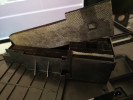When I started looking for the problem described by the Ink Pad is end of service life error message, I found that the printer had filled the waste ink reservoir, which is squirted there when cleaning the nozzles. Oh well, just pour out the reservoir and clean it, like a coffee maker, right?
It's not officially that simple. My Epson L355 and other printers keep a count of how many times the ink has squirted out sideways, and once the factory limit is reached, you've reprinted. You simply don't start another print, even if the printer is otherwise physically perfectly fine.

Calling Epson for help
When I found some free time about three weeks later, I called Epson for advice. But lo and behold, the machine tells me right off the bat that no one will talk to me until I report the serial number of the product. Yes, most of all, I love it when I have to dismantle the mess on my desk to dig to the back of the printer and read its label.
So I call again, report the number to the human voice on the other end, and I can describe what my problem is. I learn that the canister is full and the only solution is repair at an authorized service centre. The lady helpfully tells me where to find such an authorized service and that's the end of it. Unfortunately, she sends me to another city.
So instead of taking Epson's advice, I try an internet search engine and find out the price at a service centre in Brno. Apparently this is a common problem, because I get a price quote immediately. Thank you, I will think about whether to get a new printer.
Just a screwdriver and a click of a button
There is nothing wrong with the printer at first glance. It's not just a software thing? Isn't there any way to hack it? The printer's out of warranty anyway. And actually, where's the waste ink tank if it's not user-emptyable? All questions.

A little googling and my hands find the solution:
- The Epson L355 has a conspicuous screw on the back. Just unscrew it, which releases the waste ink tank. It can then be removed by gently sliding it out.
- The reservoir is actually a tray filled with felt, which serves to soak up the ink splashed. In my printer it is already completely black and soaked. But on the other hand, not to the point that anything is outright dripping out of it, or that the bottom of the tray is wet. I have chosen probably not the ideal, but quick solution. I dried the felt a bit using kitchen paper, and wrung it out a bit. Then I put it back in the tub and put everything back in place.
- Even if I had some new original accessories, this operation would have been of no use to me. I still need to do a software reset of the waste tray usage counter. There are several free programs for Windows, I download the WIC Reset Utility, whose home page looks legit, and it will also run on macOS and Linux.
- 'When you turn on the printer, the WIC Reset Utility detects the machine, displays diagnostics, and offers to reset the ink tank counter. For a full reset, this program requires a key for about a few bucks, and the first use with a reset to 80% capacity is free. I take advantage of this and have peace of mind again for the next few years. Hopefully.
So fixing the Ink Pad is end of service life error is a relatively simple matter, and I dare say you don't actually need the screwdriver. I prefer to check the condition of the tray.

By the way, if for peace of mind you really want to replace the felt in the tray, then just look on Aliexpress. It's a very low investment.
Note: I was advised by Epson media reps over the phone that newer printers already have a waste ink tank that is commonly available and user replaceable. Which sounds like a significant improvement on the situation described in the article. Maybe I can try it out in the future and share my experience.




